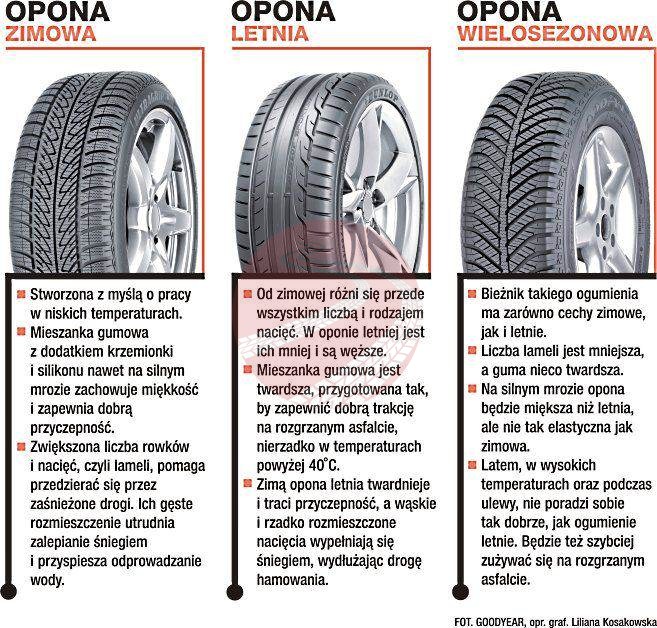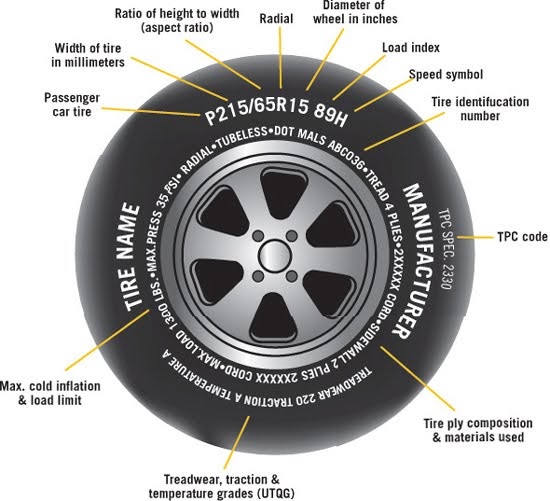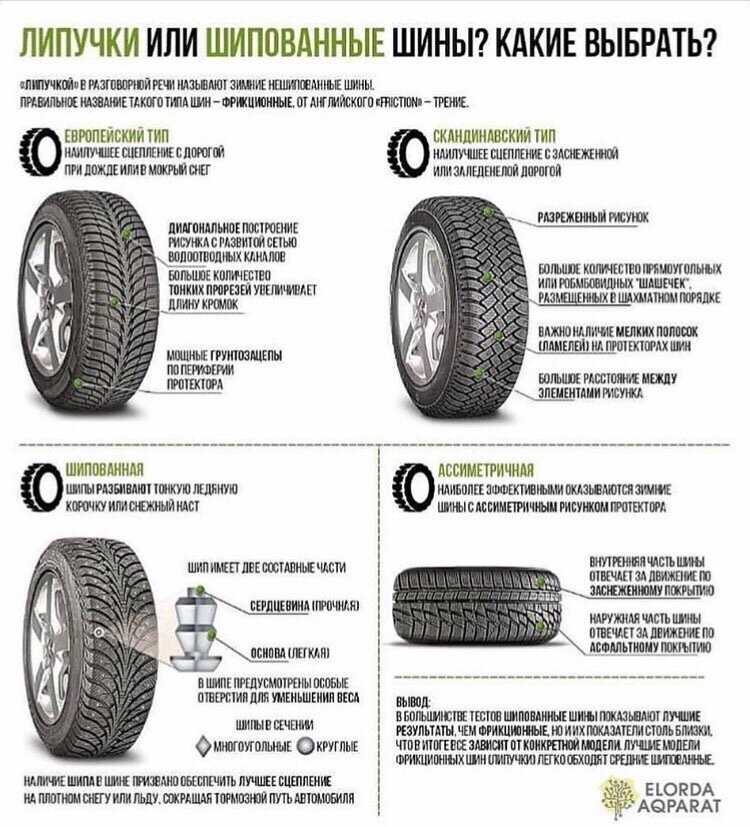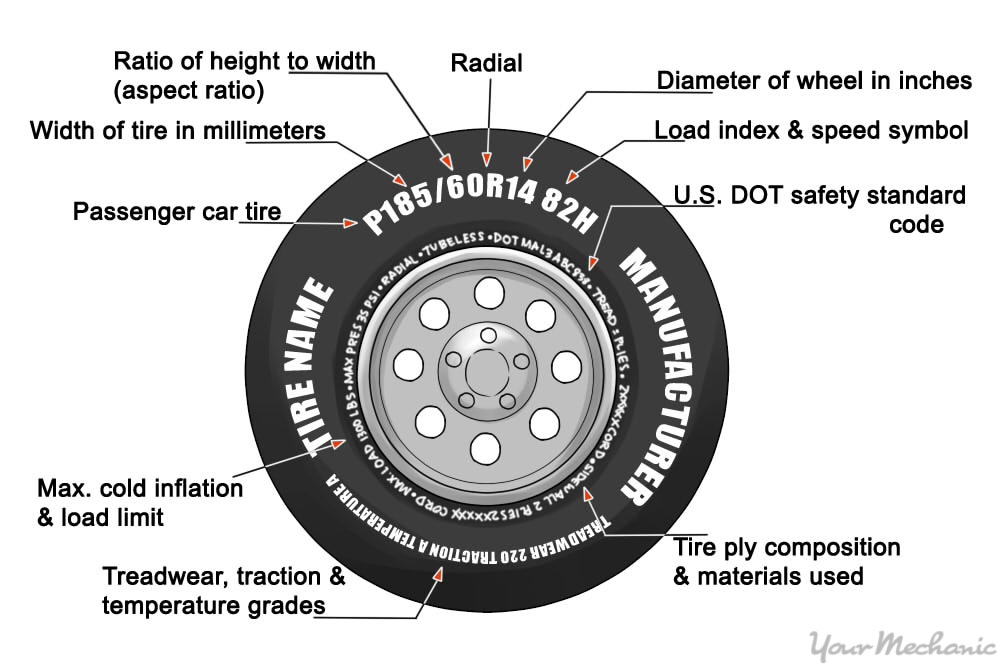There is a lot of high technology in your car tires that can be tuned from tire to tire to make them perform according to the intended vehicle type, road condition, driving style and most importantly, temperature. The main difference between winter tires and all-season tires is not something you can see. The rubber compound is by far the biggest factor in the level of winter traction you get from any given tire. The second most important difference between winter tires and all-season tires is the design molded onto the tread.
In cold weather, regular all-season tread rubber, and the rubber used in high performance summer tires, hardens at a higher temperature than the rubber compound used in snow tires. Normal all-season tire rubber hardens as temperatures drop below 42 degrees Fahrenheit. Tire rubber must be flexible to grip the road. At, or about 42 degrees Fahrenheit, an all-season and a winter tire have about the same traction, however, as the mercury drops the winter tire gains grip, while all-season tires and high performance tires, lose traction.
At temperatures well above 42 degrees Fahrenheit, the rubber in all-season tires stays hard to resist wear. In contrast, the rubber in the tread of a winter tire will soften, and wear out much faster. For this reason, winter tires should be removed from the vehicle early in the spring and replaced in late fall when the temperatures regularly dip below 42F. Even the most premium winter tires, like the Nokian Hakkapeliitta 8 or the Michelin X-Ice Xi3 are not intended to last in the heat of summer.
Another contributor to the amount of winter traction is the pattern molded into the tread. Long lasting, summer tires typically have solid ribs, separated by wide circumferential grooves. This type of tread is optimized for long tread-life, good fuel efficiency and a quiet ride on smooth roads. Regular all-season tires often have solid tread blocks arranged in a chevron-shaped pattern with wide grooves. These treads are ideal for evacuating water from under the tread, but for traction on ice and snow, tires need a high density of biting edges. Tire Engineers achieve this by molding tread narrow slits into the tread features. Often the tread features are covered in this fine slits, or tread sipes. Tread sipes provide a biting edge, while maintaining the integrity of the tread for better handling and lower noise levels. Examples of winter tire styles with very high sipe density to aid in snow and ice grip are the Arctic Claw TW1, Bridgestone Blizzak WS80 and Antares Grip 20 tire.
These treads are ideal for evacuating water from under the tread, but for traction on ice and snow, tires need a high density of biting edges. Tire Engineers achieve this by molding tread narrow slits into the tread features. Often the tread features are covered in this fine slits, or tread sipes. Tread sipes provide a biting edge, while maintaining the integrity of the tread for better handling and lower noise levels. Examples of winter tire styles with very high sipe density to aid in snow and ice grip are the Arctic Claw TW1, Bridgestone Blizzak WS80 and Antares Grip 20 tire.
The name of the tire, and the markings on the side of the tire are also an indication of the intended use. A common marking on a winter tire is the Three Peak Mountain Snowflake Symbol. When this marking is on a tire you know it meets specific snow traction performance requirements set by the Rubber Manufacturer’s Association of America and the Rubber Association of Canada. All-season tires never have this marking. More typically, all-season tires will have the more generic M+S marking. M+S marked tires are not a good indicator of performance on cold winter roads, ice, or even packed snow.
More typically, all-season tires will have the more generic M+S marking. M+S marked tires are not a good indicator of performance on cold winter roads, ice, or even packed snow.
Tires-easy.com has a huge variety of winter tires for all types of cars and driving styles. Use our tire selector to find your size and tire brand and style to fit your budget.
Create an account for free on Tires-Easy.com and check out the discounted prices on a great selection of tires.
Sign Up
You can identify winter tires by the symbols on the sidewall. These are the M+S symbol and the three-peak mountain snowflake (3PMSF) symbol, and both are industry standards.
So far, the well-known M+S mark was sufficient as a winter tire label. The 3PMSF symbol (snowflake) is mandatory for winter or all-weather tires produced since January 1, 2018.
Until September 30, 2024, there is a transition period in which winter tires with M+S labeling that have already been manufactured still meet the winter tire requirement.
However, it is definitely advisable to convert to new winter tires with the 3PMSF symbol (snowflake) soon, as they have to prove their quality in a standardized brake test on snow. This was not yet necessary for the M+S winter tire marking.
2. Three-Peak Mountain Snowflake symbol
When shopping for winter tires, it is important to look for a tire that displays the Three-Peak Mountain Snowflake Symbol (also referred to as the ‘Alpine’ symbol) on the sidewall. Transport Canada acknowledges that tires displaying this symbol meet the specific snow traction performance requirements, and have been designed specifically for use in severe snow conditions.
1. M+S symbol
What is the difference in snow traction between an M+S (Mud and Snow) branded tire, an all-season tire, and a purpose-built winter/snow tire? While many drivers probably are not absolutely sure, it can be the difference between getting to work, getting home, or getting stuck.
The original definition of M+S tires is based on the geometry of the tread design. The M+S designation was first used to differentiate the knobby, bias ply tires intended for use on muddy and/or snow-covered roads from the straight rib tires used on early cars or trucks. Tires with tread designs that meet the definition may be branded with the letters "M" and "S" in several different ways (e.g., M&S, M+S, M/S, MS, etc.) at the discretion of the tire manufacturer.
All winter tires that are marked with the Alpine symbol (pictured below) undergo the ASTM F 1805 tire test on medium-packed snow in standardized testing conditions to ensure their snow traction performance meets the minimum industry requirements to be considered a winter tire. Importantly, tires that are manufactured for medium-packed snow are required by law to perform this test and may display the 3PMSF symbol on the sidewall.
Continental recommends to use winter tires with the "Alpine" symbol on the sidewall and a tread depth of at least 4 mm in winter conditions.
Many SUVs and Off-road-Vehicles are equipped with tires carrying the "M+S“ marking on the sidewall. The reason for this is that this vehicle category was first offered in North America where all-season tires with "M+S“ marking are customary. Within the tire portfolio of Continental this applies for example to the product lines ContiCrossContact LX, ContiCrossContact LX Sport or Conti4x4Contact.
M+S marking is officially defined in an EU directive as meaning: “a tire with a tread pattern and structure designed to better performance in snow than that of a normal tire”. The performance of “M+S” marked tires is therefore neither defined nor measured.
The snow performance of winter tires is specified in North America with the so-called "Alpine" symbol. Only tires which meet or exceed these requirements may carry the "Alpine" symbol.
2022/25/04
Buying winter tires
Winter tires have unique attributes that mitigate the risks of snow, ice, and falling temperatures on the road, providing motorists with greater control.
Read more
2022/25/04
Tread on winter tires
Tread is important in every season, but even more so when roads are slippery, cold and frozen, so check your winter tires!
Read more
2022/09/12
Winter tire laws in Canada
Read more
The right choice of car wheels will allow you to move in comfort and safety. Rubber must strictly correspond to the season, road and temperature conditions. Incorrect use of wheels significantly increases the braking distance, the service life of the wheels, and the economy of movement. It is not surprising that manufacturers produce summer and winter tires, and today universal all-season tires are becoming especially popular. It is worth figuring out how to distinguish winter tires from summer tires, and for this you need to study the main characteristics of the wheels. nine0003
Rubber must strictly correspond to the season, road and temperature conditions. Incorrect use of wheels significantly increases the braking distance, the service life of the wheels, and the economy of movement. It is not surprising that manufacturers produce summer and winter tires, and today universal all-season tires are becoming especially popular. It is worth figuring out how to distinguish winter tires from summer tires, and for this you need to study the main characteristics of the wheels. nine0003
Tires for the cold season are distinguished by a carved and deep tread pattern, which can look like a familiar “herringbone” or chaotic depressions. Lamellas or zigzag cuts on the tread are the virtues of winter tires. It is they, as well as checkers and deep grooves, that provide effective removal of snow and water, increase the coefficient of adhesion on the road. There are two main types of tread pattern for winter:
Scandinavian - the pattern is sparse, the checkers are staggered and look like rhombuses, there is a noticeable distance between the elements of the pattern; nine0003
European - the pattern is located diagonally, the network of channels is well developed, powerful lugs are located on the periphery of the tread, there are a large number of thin slots - lamellas on the surface.
Summer tires have shallow tread grooves designed to expel water, the number of sipes is kept to a minimum. There is no micro-pattern in the wheels for summer.
Spikes are another criterion of seasonality. There are no summer studded tires, and winter studding should be chosen carefully. The studs are designed for driving on ice, providing good grip where other wheels slip. They should not be located in two rows on the sides of the tires - this will not shorten the braking distance at all, and the spikes themselves will fly out after several trips. High-quality studding suggests an asymmetric or snake-like arrangement of spikes. nine0003
In addition, rubber for winter tires is softer and more elastic, it is visible to the naked eye for an experienced driver. This is easy to determine even by touch, since there is an order of magnitude more rubber in the rubber compound, which allows the tires not to freeze at low temperatures. Summer tires, on the contrary, are more elastic - there is less rubber in them, because in the heat soft tires “float” and do not hold the road. For safety reasons, summer tires are resistant to wear and high temperatures. nine0003
For safety reasons, summer tires are resistant to wear and high temperatures. nine0003
During operation, winter tires warm up and therefore do not lose their elasticity and softness. On winter snowy or icy roads, this provides maximum grip, effectively shortening the braking distance. Summer tires cool down at speed, becoming more shaped and firm.
An important quality of rubber, which makes it possible to distinguish between summer and winter tires, is the maximum permissible speed. In winter, even on the highest quality roads, it is not recommended to drive faster than 140 km / h; summer tires are more democratic in this matter. nine0003
Despite everything, even a novice driver will be able to determine the seasonality of tires by special designations used by manufacturers. The letters M + S (mud and snow), as well as W (Winter - winter) guarantee comfortable driving in snow and mud, in some cases MS is the marking of all-season tires. Also, an image of the sun (for summer) and snowflakes (for winter wheels) is applied to the side surface of the wheels. It is important to know that there is no special letter designation for summer tires. nine0003
Also, an image of the sun (for summer) and snowflakes (for winter wheels) is applied to the side surface of the wheels. It is important to know that there is no special letter designation for summer tires. nine0003
Before the next winter, motorists who have driven for several seasons on studded or friction tires have a question. Should I buy new ones or old ones are still able to provide reliable grip on snow and ice? To make the right decision, you need to know how to determine the wear of winter tires, and what is its maximum allowable limit.
The main indicator of the suitability of tires for operation is the tread height. However, in the case of studded tires, the number of studs is an equally important factor. Even when there are almost none left, some motorists are in no hurry to get a new thing. Such drivers mistakenly think that in this way their tires have become frictional. nine0003
But tires, which are popularly called Velcro, have a completely different rubber compound. They are much softer than studded ones and lose their valuable properties faster in the cold.
Winter tire wear is estimated according to the following indicators:
The "List of malfunctions and conditions under which the operation of vehicles is prohibited" establishes a critical tread wear of a winter tire - 0.4 cm. But most manufacturers of studded and friction tires recommend changing earlier. To measure the tread height, a regular ruler will do. If the result is 0.5 cm, it is better to purchase new tires.
It is necessary to measure the tread height not in one place, but in several, since wear can be uneven. For example, 0.6 cm may remain on one side of the tire, and 0.4 cm on the other. In this case, it is necessary to change the tires. You can buy winter tires at the TopDetal.